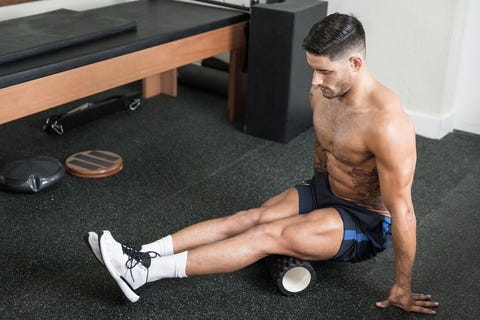How Making Time for Active Recovery Will Boost Your Workouts
Whether you’re the kind of guy that likes to hit the Muay Thai gym on the weekends or you’re more into a CrossFit and post-WOD beers with friends situation, there’s one thing that every fitness buff has in common: a desperate need to recover. If you’re not taking the appropriate time to rest and give back to your body and mind, all of that hard sweat-dripping work could be for nothing.
Exercise-related soreness, otherwise known as delayed onset muscle soreness (DOMS), generally worsens within 48 hour after training and lingers around for a few days. While a Game of Thrones and immobile-on-the-couch for-hours scenario can feel like the best response to those aching muscles, getting a little active recovery can help repair the micro-trauma—or small muscle tears that occur when lifting.
Active recovery, which calls for low-intensity exercise and movements, is a popular and scientifically proven way to expedite the process which the body returns back to pre-training levels of function and performance.
Polish researchers found that an active recovery protocol—in this case light cycling or arm ergometer work—is an effective strategy for reducing overall fatigue from muscles worked during exercise. Another research review from the Department of Health Sciences at the University of Colorado found that 6 to 10 minutes of active recovery reveals consistent positive effects on performance.
What Counts as Active Recovery?

skynesherGetty Images
You don’t have to reinvent the wheel to get up and moving through your soreness. “Think of active recovery as any low impact activity that gets your heart rate up a bit and the blood flowing to flood the muscles with nutrients and clear out metabolic waste,” Jonathan Amato, P.T., D.P.T., O.C.S., C.S.C.S. of Bethpage Physical Therapy tells Men’sHealth.com. “It could even be the same exercise or activity that you performed rigorously, with much less intensity.”
Did you have a super-heavy leg day with back squats and deadlifts yesterday and can’t walk today? Amato says that active recovery could even include repeating those movements a day later with only 25 percent of your 1RM (1-rep max). “This will significantly cut down on the effect of DOMS and how long it lasts,” he says.
Of course, there are other assisted recovery techniques that have you doing something that aren’t technically considered active recovery. Coined “passive recovery,” things like massage, stretching, cryotherapy, and cold-water immersion can also have an impact, according to Zach Murray, C.S.C.S. There’s just one caveat: “There’s minimal research on these techniques that shows substantial evidence supporting their use, besides a possible psychological component of the person ‘feeling’ more recovered,” he says.
How You Can Use Active Recovery

FG TradeGetty Images
Ready to move past Monday’s workout and get ready for the rest of what’s on tap for the week? Here, Amato recommends three different types of active recovery every caliber athlete can benefit from:
Swimming
Opt for slow, easy laps instead of heart-bumping butterfly sprints. Not only is splashing around low impact, but Australian research shows that a swim-based recovery session enhanced following day exercise performance for runners.
“It’s a total body exercise and can generate a good heart rate to increase blood flow to those starving muscles and is very easy on the joints,” he says.
Do: 20 to 30 minutes of varied strokes such as freestyle, breast, and side.
Soft Tissue Release (STR)
Self-myofascial release such as foam rolling, massage stick, massage ball, or vibrational therapy (think Theragun or HyperVolt) are simple to do on your own at home and require minimal effort. One study from Canada links foam rolling specifically to decreased muscle soreness after exercise, while others suggest it slashes injury risk, reduces muscle pain, improves flexibility, and increases vertical jump. “With our clients and patients, we use it consistently as anecdotally there is a resounding yes as to whether or not it helps them recover,” says Amato.
Do: Hit each of the large muscle groups for a minute each, never staying in one spot too long, at least twice weekly. (For more how-to tips, check out our guide on How Foam Rolling Works.)
Yoga
The best thing about yoga is you need absolutely nothing to get your downward dog on (although a mat can be helpful to ease joints on a hard surface). Avoid a gut-busting Bikram session in favor of hatha, a slow style for optimal stretching and recovery. “If financially able I recommend going to a class where your form can assessed and critiqued,” says Amato. “However a DVD at home is better than doing nothing.”
Do: 30 minutes at least one weekly
Source: Read Full Article
